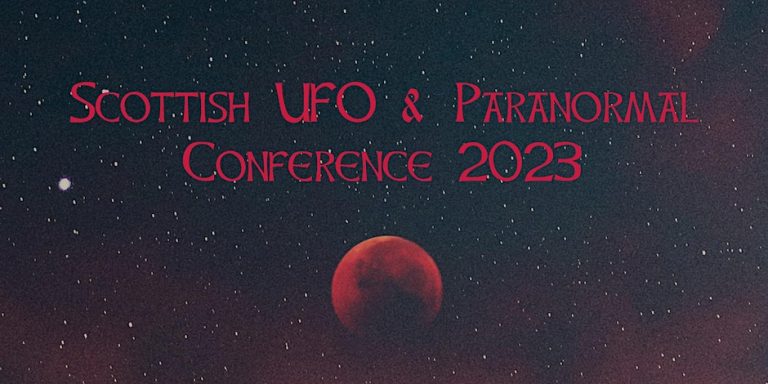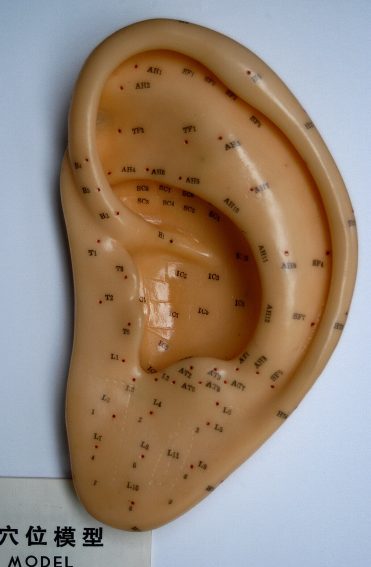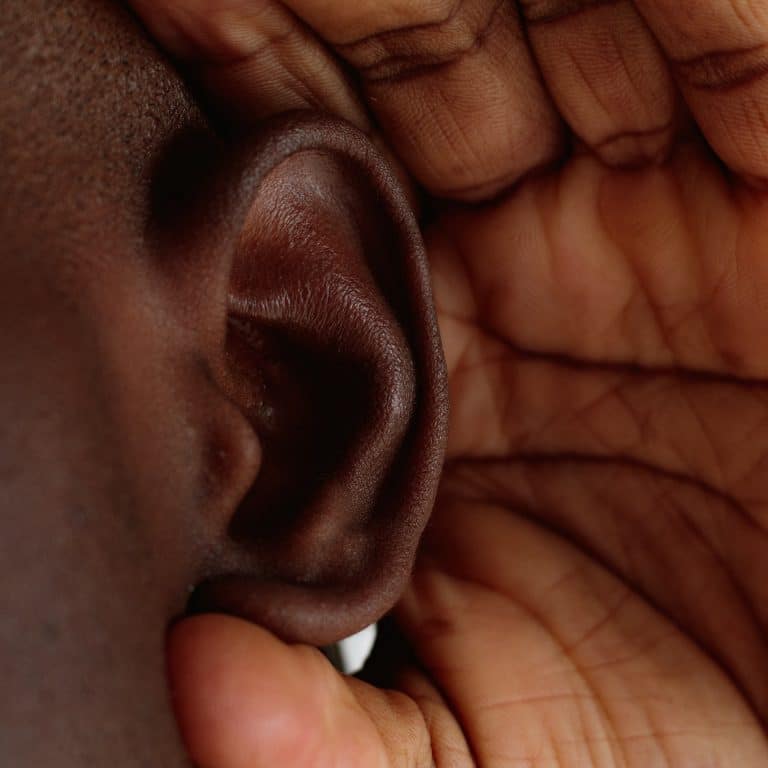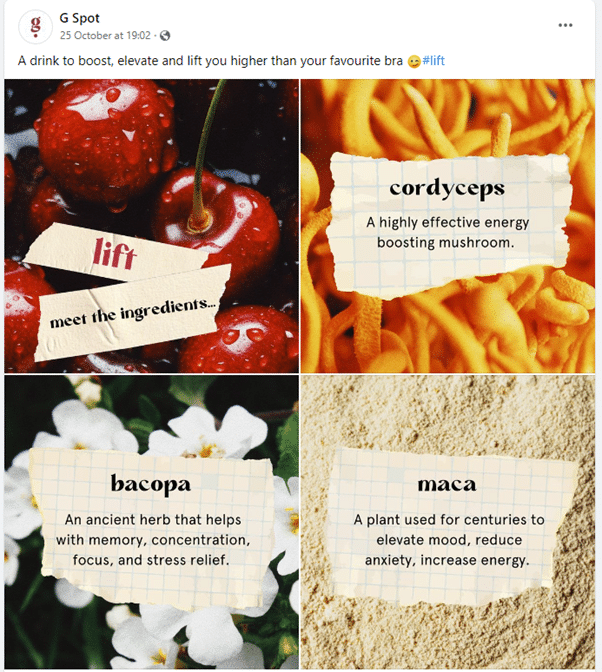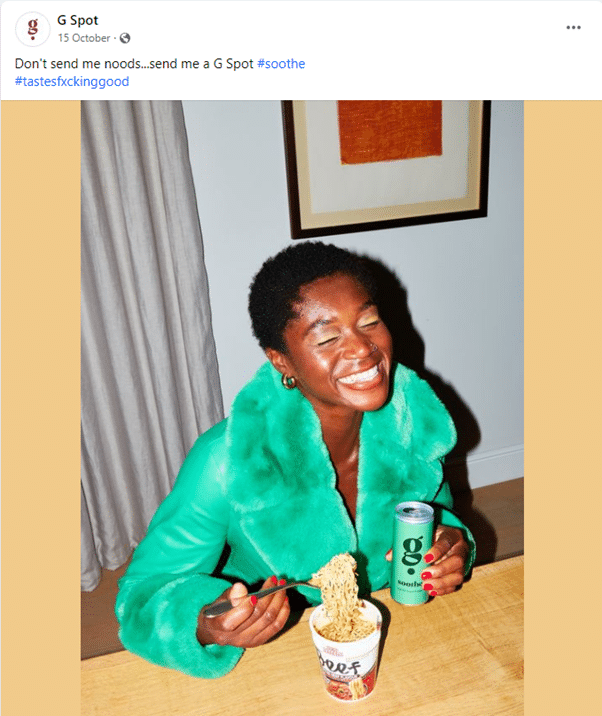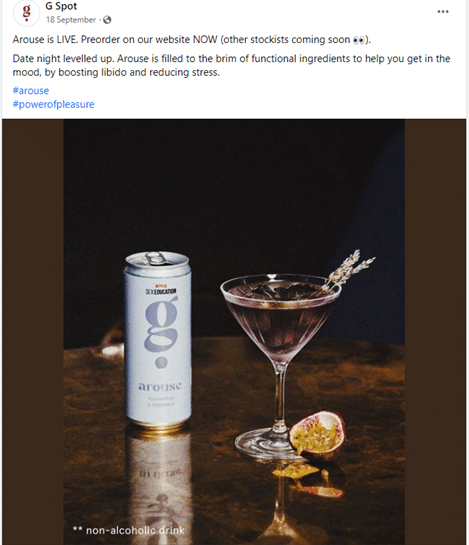In difficult times we all like to bathe in a little nostalgia and escapism. Casting your mind back to when life was less complicated is a form of low-budget therapy that we can all indulge in once in a while. With this in mind, the opportunity for some classic, old-school skepticism proved just too much to resist when the Scottish UFO & Paranormal Conference rolled around in the summer of 2023. At the bargain price of £10, what better way to spend nine hours on a Saturday? Well, lots, but we’re gluttons for punishment. It proved to be an interesting day, and also a telling reminder of the first rule of skepticism*.
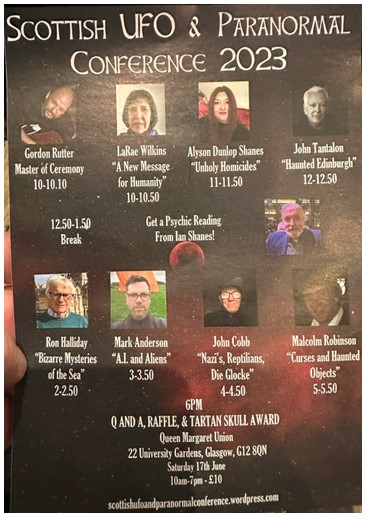
So, a small collective from Glasgow and Edinburgh Skeptics wandered into Glasgow University’s Queen Margaret Union and sat down among the 70-80 people. It’s disappointing that a prestigious hub of education is willing to rent their room out to peddlers of pseudoscience, but no doubt there are bills to be paid and they’re not in a position to turn down opportunities for income.
In terms of demographics, the audience appeared almost entirely white, with a small male majority, and an average age somewhere in the 40s or above. Suffice to say we didn’t visibly stick out, although we were identified during the day (more on that later).
Before kickoff we were treated to the obligatory view of someone’s Windows desktop view projected in all its glory, after which the MC Gordon Rutter of the Edinburgh Fortean Society got the welcomes and housekeeping out the way with aplomb. Credit where credit’s due, he kept things moving well throughout, and took us nicely through the day’s talks.
LaRae Wilkins: A new message for humanity
It was a bold move by the organisers to have such an ‘out there’ opening speaker. Even by the out-of-this-world standards of the conference, LaRae Wilkins’ content was both hard to swallow and hard to follow. This was not helped by the lack of remote for progressing the slides for the first half of the talk, and her admission that the wrong version of her PowerPoint slides had been loaded up.
The crux of her content was that aliens are here on earth, but mostly ‘hiding’ in the oceans. Apparently, they came here in 1947 because of the nuclear bomb, presumably incurring some travel delays after hearing about Hiroshima on the intergalactic airwaves. The mixed message here is that the aliens came due to the damage we were doing to our planet, but we are somehow to fear and do battle with them.
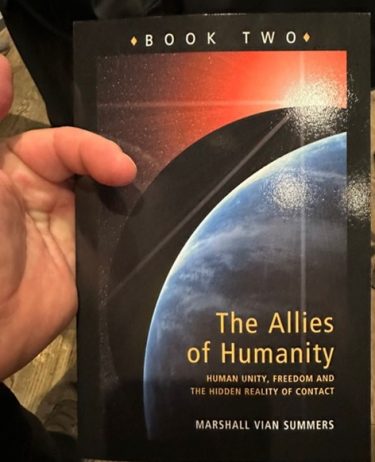
She seemed somewhat emotionally fragile, telling the audience that she had started dabbling in spirituality after the death of her husband in 2015. In a traumatic time of her life she came across the writings of Marshall Vian Summers, although in her words he didn’t actually write those words, but ‘channeled’ them. His movement is a strange one that mixes Christianity and aliens, known as Exotheology.
“We are considered a very promising race in the galaxy“.
The good news from Wilkins was that we all have the spiritual power of knowledge, and a deeper intelligence resides within us all. Fortunately, she knows a hypnotist who can help abductees break through the memory repression. We have the power to send them packing. Apparently.
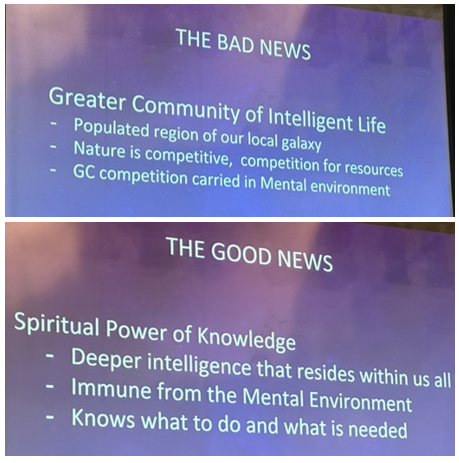
Alyson Dunlop Shanes: Unholy homicides – Sacrifices, Serial Killers, and Cults
We’re brought back down to earth with a baffling thump next, as conference organiser Alyson Dunlop Shanes almost completely eschews the paranormal, and reveals what appears to be a new desire to add to the already massive cohort of true crime podcasters. We’re taken on a tour of cattle mutilation, human sacrifice, religiously motivated atrocities, serial killers, and superstition-fuelled violence.
The irony of highlighting the harms caused by unfounded beliefs at an event dedicated to them completely washes over the speaker and the audience, but the content is interesting enough nonetheless. Unfortunately, a bad taste is left in the mouth with some extended speculation about the potential identity of Scottish triple-murderer Bible John.
At no point during the talk was any paranormal or alien intervention suggested, which was the biggest mystery of the day.
John Tantalon – Haunted Edinburgh

This talk would have been much better if we’d been huddled in a tent in the wilderness and John was pointing a torch up towards his face. What we got was a series of ghost stories from John and his counterpart Kerri. The stories came from their book. They’d like to make it very clear that they’ve got a book. It’s available to buy from their stall at the back of the room. They also have a YouTube channel. And they do ghost tours. Did I mention their book?
At no point do we get any evidence to back up their stories, and our colleague Sean Slater from Edinburgh Skeptics points out that every story told included one or more of the following qualifiers:
- ‘So the story goes’
- ‘I was told this by…’
- ‘Supposedly…’
- ‘Some reports say…’
Starved of any evidence, we break for lunch.
Lunch and a ‘psychic’ reading
After a quiet debrief over a sandwich and an Irn Bru, I steal away from my Skeptical colleagues to get a short reading from alleged psychic, Ian Shanes. I’ve had a few readings in my time but this was the least impressive. Nothing revealing or insightful was brought forward, although there was the common thread I’ve seen in all psychic readings that there’s something bigger and better out there for me. Perhaps it speaks to the wants and needs of their average client: some sense of dissatisfaction with how their lives have turned out, and/or a desperate desire to make a connection with a deceased loved one.
The best I can say is that Ian seemed like a nice person and was keen to tell me what he may have believed I wanted to hear.
Ron Halliday – Bizarre Mysteries of the Sea
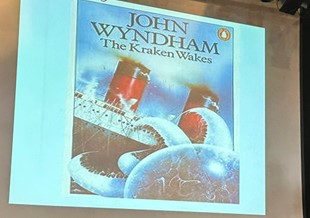
By this point of the day, we’d already seen a fair amount of unpalatable speculation about real-life tragedies but Ron Halliday took things up several notches with a tidal wave of nonsensical nautical nastiness, happily swimming over the watery graves of those who have perished in already well-understood disasters.
The Titanic gets a mention of course, with a sea monster slide played for laughs, followed shortly after by suggestions of underwater aliens being a possibility (it was later clarified that these were different from the aliens mentioned during the first talk of the day).
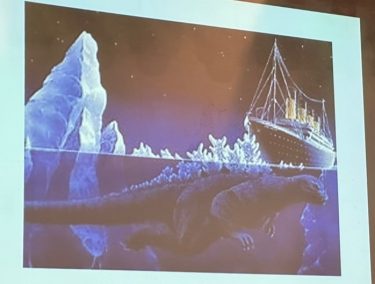
The Bermuda Triangle predictably crops up too, with some special attention being paid to the case of ‘Flight 19’, which has already been explained in detail without the need for anything supernatural (see Skeptoid episode 417 for a good breakdown). If you’re still marking your bingo cards, we also get tips of the hat to the Loch Ness Monster, the Mary Celeste, and Atlantis.
It’s around this point that my resolve breaks and I unleash some scathing Tweets about proceedings. This, combined with Edinburgh Skeptics’ more objective content, along with pictures, allows the organisers to triangulate where we are in the room. For the rest of the day, we have various team members coming over and sitting next to us, presumably to pressure us into behaving ourselves. Ever get that sinking feeling?
Mark Anderson – AI and Aliens
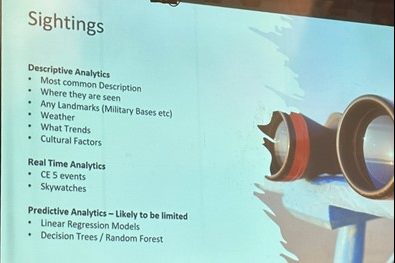
My day job is with a large technology consulting company, which meant that during Mark Anderson’s talk I was worried I’d somehow been teleported back to the office. Mark clearly works in the industry, and is basking in the honeymoon period of expectations regarding what artificial intelligence can bring to the world. His PowerPoints have a corporate look about them too, with a marked difference in format from the rest of the speakers.
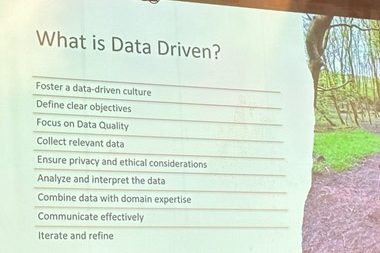
He does make some excellent points about how bad humans are at capturing and interpreting data, with tendencies for biases and ignorance to tarnish any judgment on any aerial phenomena that are encountered. His proposal therefore was for a more data-driven approach to evaluating UFO/UAP sightings, standardisation of processes, utilization of non-human sky monitoring technology, and AI for interpreting the large amounts of data that would bring.
These ambitious but admirable suggestions were sadly marred by the fact that he’s already come to the conclusion that aliens are amongst us, and mentions of things like dream diaries as potential sources of evidence didn’t help either. This was as close to rationality as we would get the whole day, though, and we had an interesting chat with Mark after the conference ended.
John Cobb – Nazi’s, Reptilians, Die Glocke

My hackles were already up before John Cobb started speaking due to the misplaced apostrophe in the title of his talk. He didn’t help matters by launching into a somewhat disjointed and largely incomprehensible journey through a series of conspiracy theories which somehow managed to be even less credible than anything the previous speakers had been able to dredge up.
Die Glocke was allegedly an anti-gravity ‘UFO’ that the Nazis were working on. There’s allegedly time travel involved as well, with a 2039 Nazi coin being cited as evidence. For good measure we get secret societies and collaboration with reptilian aliens, too. Cobb clearly has some health issues which may have contributed to the rambling nature of his content, but even the most polished of speakers couldn’t have made this sound anywhere near credible.
![A slide titled "The Alpha Draconian Dracs." with an image to the left of a "REPTILIAN" complete with description, "Origin: Alpha Draconian, Agenda: Conquer and Dest[illegible], Life Span: 500 Earth Years, Ship Shape: Cigar & Tear D[illegible], Base: Technologies, Note: R". Below the Dracs heading reads "There are several arguments that claim the Sumerian writings are not enough evidence to link to the Reptilians to these strange Anunnaki. What cannot be denied, however, is the many Reptilian theories that have come to light as a result of the Sumerian writings."
Source: Brian Eggo](https://www.skeptic.org.uk/wp-content/uploads/2023/11/Alpha-Draconia.jpg)
Malcolm Robinson – Curses and Haunted Objects
The final speaker of the day is apparently well-known in paranormal circles. His Amazon biography is a work of art in itself (“Malcolm has also seen a pair of levitating shoes fly up into the air and crash through a glass window”), but there’s one thing that it conspicuously doesn’t mention: Malcolm has found the ‘Animations’ pane in PowerPoint. Thankfully, Malcolm addresses that glaring omission by treating the audience to a display of dramatic text gymnastics reminiscent of an Adam West-era Batman fight scene.
KERPOW-ERPOINT!
![Slide with text over a black and white image of James Dean wearing a cowboy hat, titled "PRIOR TO THE CRASH". It reads "Eartha Kitt and Dean's former girlfriend Ursula Andress - said that they felt that the vehicle had a malevolent presence about it.
Ertha Kitt [sic] is reported to have said the following to Dean while the two were out for a drive the week before Dean's crash. She said, "James, I don't like this car, it's going to kill you,"
Around the same time, Dean introduced himself to Alec Guinness and asked the actor's opinion of the car. Upon seeing it, Guinness stated that the car was sinister, and said that if Dean got into it, he would be dead within the week." The photo is captioned "James Dean on the set of 'Giant'".
Source: Brian Eggo](https://www.skeptic.org.uk/wp-content/uploads/2023/11/Prior-To-The-Crash-375x287.jpg)
His talk continues the day’s grave-trampling theme by heartlessly parroting all the internet-fabricated scare stories about the curse of James Dean’s car. The ‘best’ kind of sensationalism is the kind that seamlessly weaves in the unproven along with the actual facts, and the speaker is clearly adept at this as he takes some well documented aspects of the crash and its aftermath and garnishes them expertly with hearsay and urban myths.
There’s also lying by omission as he talks about the curse of the crying boy pictures; yes, a firefighter in the 1980s did claim (with the emphasis on claim) that prints of the various crying boy pictures ‘mysteriously’ survived house fires (allegedly) unscathed.
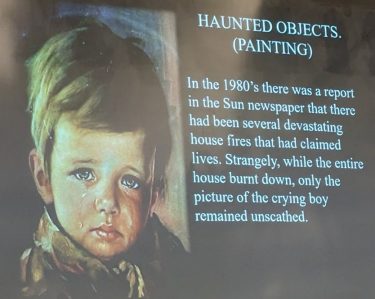
The pictures are also occasionally blamed for the starting of the fires in the first place. Of course, there’s no good reason to believe these claims, but conspicuously there’s no mention from the speaker about the tens of thousands of these prints that were sold in the UK without incident. There’s also a high probability that many such pictures were destroyed in house fires without being reported, and those that survived fires could have done so for perfectly mundane reasons such as falling face-down onto the floor, the severity and spread of the fire, and the potential fire-retardant properties of varnish/lacquer.
Malcolm also fails to mention that the supposedly (magical) fire-resistant pictures were successfully burned in a bonfire in what appears to be a rare piece of attempted investigative journalism from The Sun. The talk degenerates further from there as the speaker meanders from the well-known (Tutankhamun), to the comedically obscure, with Gillette razor advertising and first-time winners attempting to retain the World Snooker Championship at the Crucible Theatre taking the cursed cake.
Q&A and wrap-up
The conference ends with a whimper rather than a bang as MC Gordon Rutter does his best to run the Q&A smoothly despite the lacklustre audience questions, and having more speakers than microphones up on stage (cue some awkward pass-the-parcel type shenanigans). To add insult to injury, I failed to win anything in the raffle despite the fact that there were almost as many prizes as there were attendees left in the room by this point.
*I’m somewhat embarrassed to say that my key takeaway from the event was to remember not to be a d–k. I was rightly called out for my snarky Tweets. I deleted them and apologised.
It’s genuinely hard not to find the ridiculous funny, and not to find idle speculation about genuine human tragedy distasteful, but in terms of the bigger picture of the world we live in right now, the levels of harmfulness were comparatively low; there was no homophobia, transphobia, racism, anti-vaccine or anti-woke sentiment.
There were several mentions of climate change as a real phenomenon that needs addressing, and, most notably, while talking about the Nazis, it was made very clear that they were the baddies – which is by no means a given these days.
There was of course little or no attempt to be objective, to seek the actual truth, or to be intellectually honest, so it wouldn’t surprise me if many people there that day did have some problematic views on more weighty matters, but it wasn’t on display. The only lack of tolerance on display that day was due to the combined forces of my lack of restraint, and my proximity to the internet. I hope we can all do better next time.

